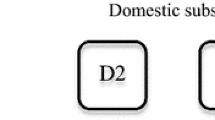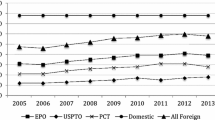Abstract
This paper introduces a methodology for the construction of a country level patent value indicator based on the family size of a country’s patent profile at the level of technology fields. Because individual family members target different markets and technologies have a different propensity to internationalization, family size has been shown to have a restricted power to assess the quality of patent profiles of countries. We address this gap by weighting the members of patent families filed at different patent offices before calculating the family size indicators, to account for the market potential in which the patents of these families were filed. We apply different weighting schemes and test which scheme is best able to explain the export performance of countries. In order to conduct our analyses, a panel dataset, consisting of annual data (1990–2002) on international trade from the UN-COMTRADE database and patent data from the “EPO Worldwide Patent Statistical Database” (PATSTAT), was compiled. Several bivariate analyses reveal that weighted and unweighted family counts are highly correlated, meaning that statistics based on absolute (weighted or unweighted) family counts are barely affected by the chosen weighting factor. This, however, is different when using the average family size, where weighting the family members by imports, as well as GDP, can be shown to have a robust positive effect to explaining export performance. The imports and the GDP weighted average family size are thus able to act as a consistent indicator of patent value at the country and technology field level.





Similar content being viewed by others
Notes
Our database covers 81 patent authorities worldwide. If one of the weighting factors was not available for a given country, it had to be treated as missing.
An option to this approach would have been to weight EPO and PCT applications by zero, since all of these applications are forwarded to national offices at a given point in time. This however, would have limited our analyses to the 1990s since it takes some time for PCT applications to be forwarded and EPO applications to be granted. Nevertheless, it has to be mentioned that with the chosen approach at least some of the family members could be weighted twice, once for EPO or PCT and once for the respective national office; a problem that becomes more serious the farther we go back in time.
This set of countries covers all OECD member states as well as BRICS and EU-27.
In the case that inventors from two or more different countries were named on a patent belonging to a respective patent family, the patent family was counted once for each of the named inventor countries.
Due to the priority concept and the possibility of filing patents via PCT procedures, it could take up to about 30 months from the date of priority filing in a given country until patents from the same family are published in other countries. Additionally, patent applications at the EPO are forwarded to the designated national offices after being granted, where they then count as individual family members This takes about 5–7 years on average and it takes about 7–10 years after first filing until a family is almost settled (for a more detailed overview see Frietsch et al. 2010).
This time window assures that all patents have the same chance to be cited. Not using a time window would lead to higher citation counts for older patents since they would have had a longer time period to be cited, which would cause a systematic bias.
Since the country- and technology field specific control variables are time-invariant, they drop out of the following multivariate (fixed effects) models. This does not mean that they are uncontrolled, rather that they cannot be identified.
It should be stressed that Germany, as well as the other countries in the sample, is here defined by the location of the invention and not by the office where the patent is filed. In other words, Germany here means patents invented in Germany and filed abroad.
Excluding China and Korea from the bivariate correlation analysis reveals even larger correlations for the weighted family counts.
Similar results can be found when conducting an exploratory factor analysis using principal component factors. For the family counts only one factor is extracted. When using the different average family sizes, however, three factors are extracted, with CI, LOC and PARK loading high on one common factor. The same is true for GDP and IMP.
References
Adams, S. R. (Edn.). (2006). Information sources in patents (2nd edn.). Munich: KG Saur.
Blind, K. (2001). The impacts of innovations and standards on trade of measurement and testing products: empirical results of Switzerland’s bilateral trade flows with Germany, France and the UK. Inf Econ Policy, 13, 439–460.
Blind, K., Edler, J., Frietsch, R., & Schmoch, U. (2003). Erfindungen kontra Patente. Schwerpunktstudie “Zur technologischen Leistungsfähigkeit Deutschlands”. Karlsruhe: Fraunhofer ISI.
Blind, K., & Frietsch, R. (2003). Sector-based multidimensional forecasting model (seform), report to the European patent office within the research programme: improvement of methods for forecasting patent filings. Karlsruhe: Fraunhofer ISI.
Blind, K., & Frietsch, R. (2006). Integration verschiedener Technologieindikatoren. Studien zum deutschen Innovationssystem Nr. 16-2006. Berlin: Bundesministerium für Bildung und Forschung, BMBF (Ed.).
Blind, K., & Jungmittag, A. (2005). Trade and the impact of innovations and standards: the case of Germany and the UK. Appl Econ, 37, 1385–1398.
Chen, H. (2009). A literature review on the relationship between foreign trade and economic growth. Int J Econ Finance, 1, 127–130.
Dosi, G., & Soete, L. (1983). Technology gaps and cost-based adjustment: some explorations on the determinants of international competitiveness. Metroeconomica, 35, 197–222.
Dosi, G., & Soete, L. (1991). Technical change and international trade. In G. Dosi, C. Freeman, R. Nelson, G. Silverberg, & L. Soete (Eds.), Technical change and economic theory (pp. 401–431). London: Pinter Publishers.
Fagerberg J (1996) Competitiveness, scale and R&D. NUPI working paper Nr. 545. Oslo: NIPU, Norwegian Institute of International Affairs.
Frietsch, R., & Schmoch, U. (2010). Transnational patents and international markets. Scientometrics, 82, 185–200.
Frietsch, R., Schmoch, U., van Looy, B., Walsh, J. P., Devroede, R., Du Plessis, M., et al. (2010). The value and indicator function of patents. Studien zum deutschen innovationssystem Nr. 15-2010. Berlin: Expertenkommission Forschung und Innovation (EFI) (Ed.).
Gambardella, A., Harhoff, D., & Verspagen, B. (2008). The value of European patents. Eur Manage Rev, 5(2), 69–84.
Ginarte, J. C., & Park, W. G. (1997). Determinants of patent rights: a cross-national study. Res Policy, 26, 283–301.
Greenhalgh, C. (1990). Innovation and trade performance in the UK. Econ J, 100, 105–118.
Greenhalgh, C., Taylor, P., & Wilson, R. (1994). Innovation and export volumes and prices—a disaggregated study. Oxf Econ Pap, 46, 102–134.
Hall, B. H., Jaffe, A., & Trajtenberg, M. (2005). Market value and patent citations. Rand J Econ, 36(1), 16–38.
Harhoff, D., Scherer, F. M., & Vopel, K. (2003). Citations, family size, opposition and the value of patent rights. Res Policy, 32, 1343–1363.
Hye, Q. M. A., & Boubaker, H. B. H. (2012). Exports, imports and economic growth: an empirical analysis of Tunisia. IUP J Monetary Econ, 9, 6–21.
Krugman, P. (1979). A model of innovation, technology transfer, and the world distribution of income. J Polit Econ, 87, 253–266.
Lachenmaier, S., & Wößmann, L. (2006). Does innovation cause exports? Evidence from exogenous innovation impulses and obstacles using German micro data. Oxf Econ Pap, 58, 317–350.
Legler, H., & Frietsch, R. (2007). Neuabgrenzung der Wissenswirtschaft—forschungsintensive Industrien und wissensintensive Dienstleistungen. Studien zum deutschen Innovationssystem Nr. 22-2007. Berlin: Bundesministerium für Bildung und Forschung BMBF (Ed.).
Madsen, J. B. (2007). Innovations and manufacturing export performance in the OECD countries. Oxford economic papers. Oxford: Oxford University Press.
Martinez, C. (2009). Insight into different types of patent families. Madrid: CSIC-Institute of Public Goods and Policies.
Martinez, C. (2010). Patent families: when do different definitions really matter? Scientometrics, 86, 39–63.
Narin, F. (1993). Technology indicators and corporate strategy. Rev Bus, 14(3), 19–25.
Narin, F., Breitzman, A., & Thomas, P. (2004). Using patent citation indicators to manage a stock portfolio. In H. F. Moed, W. Glänzel, & U. Schmoch (Eds.), Handbook of quantitative science and technology research: the use of publication and patent statistics in studies of S&T systems (pp. 553–568). The Netherlands: Kluwer Academic Publishers.
Neuhäusler, P., Frietsch, R., Schubert, T., & Blind, K. (2011). Patents and the financial performance of firms—An analysis based on stock market data. Fraunhofer ISI discussion papers innovation systems and policy analysis Nr. No. 28. Karlsruhe: Fraunhofer ISI.
Park, W. G. (2008). International patent protection: 1960–2005. Res Policy, 37, 761–766.
Posner, M. V. (1961). International trade and technical change. Oxf Econ Pap, 13, 323–341.
Putnam, J. (1996). The value of international patent rights. Yale: Yale University.
Ramos, F. F. R. (2001). Exports, imports, and economic growth in Portugal: evidence from causality and cointegration analysis. Econ Model, 18, 613–623.
Rosenkopf, L., & Nerkar, A. (2001). Beyond local search: boundary-spanning, exploration and impact in the optical disc industry. Strateg Manage J, 22, 287–306.
Sampat, B. M., & Ziedonis, A. A. (2004). Patent citations and the economic value of patents: handbook of quantitative science and technology research (pp. 277–298). The Netherlands: Springer.
Soete, L. (1981). A general test of technological gap trade theory. Weltwirtschaftliches Archiv, 117, 638–660.
Soete, L. (1987). The impact of technological innovation on international trade patterns: the evidence reconsidered. Res Policy, 16, 101–130.
The World Bank (2011) World development indicators. World bank national accounts data, and OECD national accounts data files: http://data.worldbank.org/. Accessed 23 September 2011.
Trajtenberg, M. (1990). A penny for your quotes: patent citations and the value of innovation. Rand J Econ, 21, 172–187.
United Nations Commodity Trade Statistics Database (2011) UN Comtrade. http://comtrade.un.org/. Accessed 23 September 2011.
United Nations Population Division (2009) World population prospects: the 2008 revision. New York: United Nations, Department of Economic and Social Affairs. http://esa.un.org/unpd/wpp/index.htm. Accessed 23 September 2011.
Van Hulst, N., Mulder, R., & Soete, L. L. G. (1991). Exports and technology in manufacturing industry. Weltwirtschaftliches Archiv, 127, 246–264.
Vernon, R. (1966). International investment and international trade in the product cycle. Q J Econ, 80, 190–207.
Vernon, R. (1979). The product cycle hypothesis in a new international environment. Oxf Bull Econ Stat, 41, 255–267.
Wakelin, K. (1998). The role of innovation in bilateral OECD trade performance. Appl Econ, 30, 1335–1346.
White, H. (1980). A heteroskedasticity-consistent covariance matrix estimator and a direct test for heteroskedasticity. Econometrica, 48, 817–838.
World Economic Forum. (2010). The global competitiveness report 2010–2011. Geneva: World Economic Forum.
Acknowledgments
The current study was funded partially in the course of a project for the German Expert Commission on Research and Innovation (EFI). An earlier version of this paper was published in a report under the auspices of the EFI.
Author information
Authors and Affiliations
Corresponding author
Rights and permissions
About this article
Cite this article
Neuhäusler, P., Frietsch, R. Patent families as macro level patent value indicators: applying weights to account for market differences. Scientometrics 96, 27–49 (2013). https://doi.org/10.1007/s11192-012-0870-y
Received:
Published:
Issue Date:
DOI: https://doi.org/10.1007/s11192-012-0870-y




